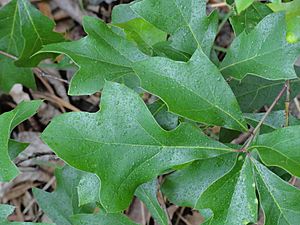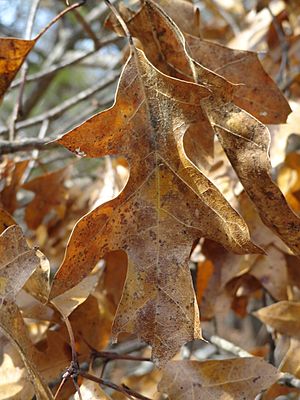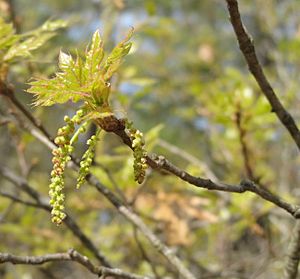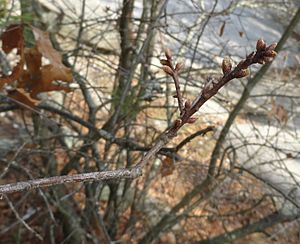Georgia oak facts for kids
Quick facts for kids Georgia oak |
|
|---|---|
 |
|
| Georgia oak leaves | |
| Conservation status | |
| Scientific classification | |
 |
|
| Natural range |
The Georgia oak, also known as the Stone Mountain oak, is a special type of oak tree. It's a red oak that loses its leaves in the fall (deciduous). This tree is quite rare and grows naturally in the southeastern part of the United States.
Contents
Where the Georgia Oak Lives
The Georgia oak is found in the southeastern United States. It mainly grows in northern Georgia. You can also find smaller groups of these trees in Alabama, North Carolina, and South Carolina.
This tree likes to grow on dry, rocky hillsides. It prefers places with granite and sandstone rocks. These areas are usually between 160 and 1,640 feet (50 to 500 meters) above sea level.
The Georgia oak was first found in 1849. This happened at Stone Mountain in Georgia. Many Georgia oaks still grow there today. You can see them along the popular walking trails. They are also found on other nearby mountains. These include Panola Mountain and Arabia Mountain in Georgia.
What the Georgia Oak Looks Like
The Quercus georgiana is usually a small tree. Sometimes, it grows more like a shrub in the wild. It can reach a height of about 26 to 49 feet (8 to 15 meters). This tree belongs to the red oak family, known as Quercus sect. Lobatae.
Georgia Oak Leaves
The leaves of the Georgia oak are shiny and green. They are about 1.5 to 5 inches (4 to 13 cm) long. They are also about 1 to 3.5 inches (2 to 9 cm) wide. Each leaf has a stem (petiole) that is about 0.2 to 0.9 inches (0.6 to 2.3 cm) long.
The leaves have five uneven, pointed sections. Each tip has a small, stiff hair. The leaves are smooth and hairless. However, they have small, noticeable tufts of hair. These hairs are found where the veins meet on the underside of the leaf.
In autumn, the leaves turn a dark red or brown color. They stay on the tree all winter long. They only fall off when new leaves begin to grow in the spring.
Flowers and Acorns
Like all oak trees, the Georgia oak flowers in late spring. This happens after all danger of frost has passed. The flowers grow in long, hanging clusters called catkins. Each tree has both male and female flowers.
These trees cannot pollinate themselves. This means they need another oak tree nearby to make acorns. The acorns are round and about 0.3 to 0.5 inches (9 to 14 mm) long. They take about 18 months to fully grow after the flowers are pollinated.
Twigs and Buds
The small branches, called twigs, are a deep red color. They are about 0.04 to 0.08 inches (1 to 2 mm) thick. These twigs are smooth and hairless. The buds at the end of the twigs are reddish-brown. They are oval to somewhat cone-shaped. They measure about 0.1 to 0.2 inches (2.5 to 5 mm). These buds are also smooth, or their scales might have tiny hairs.
Georgia Oak Bark
The bark of the Georgia oak is gray to light brown. It has a scaly texture.
How People Use Georgia Oak
Sometimes, the Georgia oak is planted in gardens or yards. It is grown as a special tree in USDA plant hardiness zones 5-8. Besides being used in landscaping, the Georgia oak does not have other commercial uses.
See also
 In Spanish: Quercus georgiana para niños
In Spanish: Quercus georgiana para niños






